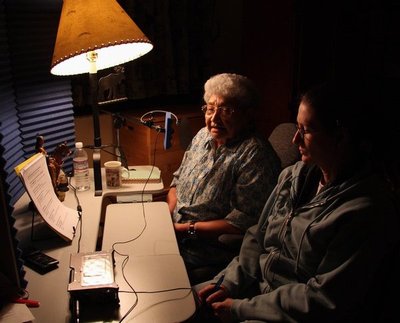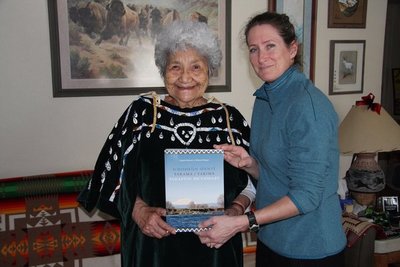April 1, 2010
A dictionary for the Yakama language, more than 20 years in the making
Creating a dictionary for a fading language can help breathe new life and relevance into that tongue. That’s why UW Linguistics Professor Sharon Hargus and Virginia Beavert of the Yakama Nation and the University of Oregon have reason to be proud — they’ve just published a major dictionary of the Sahaptin dialect of the Yakama language.
Ichishkiin Sinwit Yakama / Yakima Sahaptin Dictionary, created by Hargus and Beavert with full-color illustrations and essays by Bruce Rigsby, a linguist and professor emeritus at the University of Queensland, was published in March by University of Washington Press.
It’s a large, handsome volume — 566 pages in all, and comes with a CD of MP3 sound files as an aid to pronunciation. The book was a co-production with Heritage University, in Toppenish, Wash. The book’s Web site is hosted by the UW Language Learning Center, where the sound files are linked to the Sahaptin dictionary text.
“I was in shock for a while. I could not believe we had actually finished it,” said Beavert, who at 88 is a virtual walking dictionary and encyclopedia of the Yakama Nation. A deeply respected tribal member, she was the first woman elected to the tribe’s General Council and is regarded as one of the few remaining fluent speakers of the Yakama dialect.
The dictionary is clearly a definitive work, and one its authors say was well more than 20 years in the making.
Beavert said she had no great interest in linguistics as a young person, though she spoke or understood several Sahaptin dialects. Later, in the 1970s, her stepfather worked with Rigsby toward creating the Yakima (the tribe’s spelling then) Language Practical Dictionary, but was unable to complete it due to poor health. Beavert took over the project and the finished dictionary was distributed in 1975.
Beavert said she came to the UW in 1987 looking for a linguist with whom to collaborate on further Sahaptin language documentation projects. “I knew how to speak it but didn’t know how to structure it, with nouns and verbs,” she said. “I wanted to make sure it was correct.” She met Hargus, who offered help, and the two began working on a database of Sahaptin words. Their first project together, Beavert wrote in the introduction, was a 1990 presentation at the Society for the Study of the Indigenous Languages of the Americas meeting in Vancouver, B.C.
By the late 1990s the two had begun systematic dictionary research to supplement the earlier work. “From 1998 on we worked quite intensively,” said Hargus, “and we really started collecting lexicographic materials systematically from that time.”
In 2004 they met with officials at Heritage College, who were working with Beavert to update the 1975 material. They recruited Hargus to help with the Heritage project. By 2005, Hargus wrote in the dictionary’s preface, “I realized that there was too much overlap between the two projects, and that two competing dictionaries would not make efficient use” of their working time. She then merged the two databases.
Hargus wrote that she and Beavert “averaged nine-10 multi-day work sessions per year. … My main tasks were to analyze new material, integrate it into the database, repeatedly sort the database in various ways to spot errors and inconsistencies; organize follow-up questions, and process the audio recordings. … The sound files clearly add an extra element of quality and accuracy to this dictionary, but they added considerably to the time it took to finish the project.”
In 2008, Hargus wrote, she realized that “cross-references among many entries were not enough to show the relationships among words,” so she added a root index. “The root index basically shows a level of analysis which the earlier dictionary project had tried to capture with a different structure of the database.”
Hargus noted a few minor regrets in a section of the preface titled “Compromises made in this dictionary,” but said on the whole she is pleased with it and proud of its completion. She wrote in an e-mail, “The most positive aspect of developing the dictionary was working directly with Virginia, and filling in the picture of the lexicon from the new words and sentences that came up as we worked together.”
Hargus added, “It kind of surprises me how many people are interested in dictionaries, and how this has been so eagerly awaited. We’ve had a positive response from everyone who has looked at it.”
UW Press is pleased with the book, too. Pat Soden, director, wrote in an e-mail that the press “takes great pride in the books we publish documenting the languages and traditions of our regions’ native cultures. This dictionary of the Sahaptin language will help generations of students to keep the language alive and used.” He also expressed gratitude to Kathleen Ross, president of Heritage University, without whose “strong guidance and support,” he said, the project would not have been realized.
The University as a whole has expressed its support, too: The UW gave Beavert an honorary doctorate in June of 2009.
For Beavert, the pleasure is not just for a completed project, but for a new chance for this Sahaptin dialect to be spoken. It’s her mission to preserve the language by teaching it to young people, who then teach others.
In her part of the preface, Beavert stated her case plainly: “My message to the Yakama people is that learning to read and write your own language is very important. It is the only way to save your native language and culture for the future generation. We are losing our elders every day as they depart to a better place. My purpose in developing this dictionary has not been to benefit myself, but to encourage the younger generation to pursue an education, learn the language, teach their children to speak, read and write Sahaptin, and do their part to help preserve the native language and culture of the Sahaptin people.”
She added in a brief interview, “I am very proud of it … I am pretty well informed about my language.”


